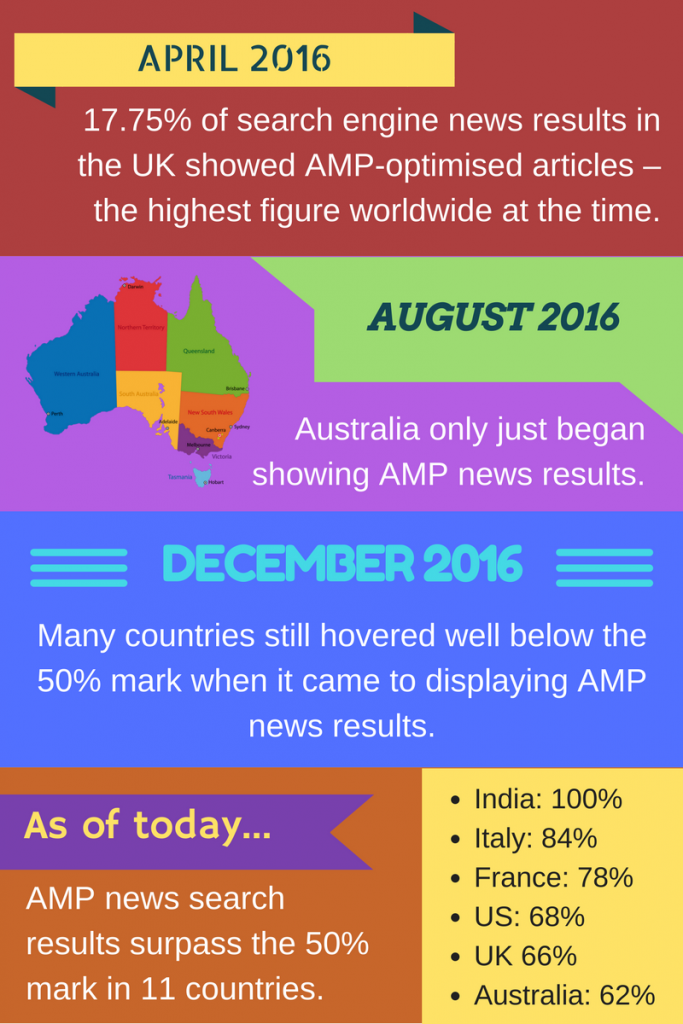AMPs Catapulting Across Google News Results

Last year, we touched on a new-fangled concept introduced by Google known as AMPs (Accelerated Mobile Pages) – a project wherein fast-loading pages specifically designed for mobile devices are given first priority when it comes to search engine results.
We started seeing the new trend trickle in throughout 2016, with the idea that there would be a huge push for AMPs in 2017. Now, just 31 days into the new year, the forecasts have well and truly crystallised into reality.
Let’s take a look at the data…
There’s no doubt about it: the latest stats illustrate the force at which AMPs have recently gained worldwide traction. To give you a bit of an overall idea of how this trend has taken shape, we’ve drawn up a brief timeline:

Let’s give this some perspective: consider for a moment that between 25th-26th January, AMP news results in France sat at 0%. Five days later, that figure changed drastically – as demonstrated in the above infographic.
Or even more impressive: on January 1st, India did not display any AMP articles on Google. Today, 100% of all results in India’s Google mobile News Box are AMP-optimised.
Needless to say, all corners of the globe are sitting up and paying attention to the latest Google trend, which begs the question…
Can we expect other countries to follow India’s lead and totally embrace AMP news articles?
Although we can only speculate at this point in time, the remarkable spike in AMP-optimised news results across the globe is a pretty good indicator that the new format may potentially take over all of Google’s news boxes in the relatively near future. And, given the degree to which users access news articles on mobile devices, it’s no wonder that Google should be pushing for Accelerated Mobile Pages.
Think about it – when was the last time you tried to open a news article on your smartphone and, after waiting a few seconds for the page to load, got fed up and cancelled the request? Google is well aware that its users don’t like to wait around, hence the reason for the super-swift incline of AMPs. After all, the beloved search engine is all about keeping its audience happy.

So, how do I know if a page is AMP compatible?
From a user’s perspective, you may have noticed web pages popping up on your search engine results page accompanied with a little tag labelled ‘AMP’. These are pages Google has certified as AMP-optimised.
But how do you know if your own pages are constructed to fit this new framework?
You are probably well aware that you can check whether your pages are mobile-friendly, but now you can also check if your pages are AMP compatible, too: all you have to do is plug your URL into Google’s nifty new tool. Has your page come back incompatible? Not to worry – you can find out more about the intricacies of how AMPs work and what elements they require here.
What does this mean for publishers?
Perhaps it goes without saying, but if you haven’t already latched onto the latest Google trend, you better get moving. Evidently, AMPs are soaring at an exponential rate and as such, publishers all over – not just news sources – should take note and adapt with the times before falling behind. By failing to optimise your website for AMPs now, you risk being knocked off your current search engine results position and fading away into SERP irrelevancy.
As 2017 continues to roll on by, we look forward to seeing how the AMP trend unfolds and impacts rankings, ultimately shifting up the Google game once more to better suit an increasingly mobile-savvy society. Bring it on.
